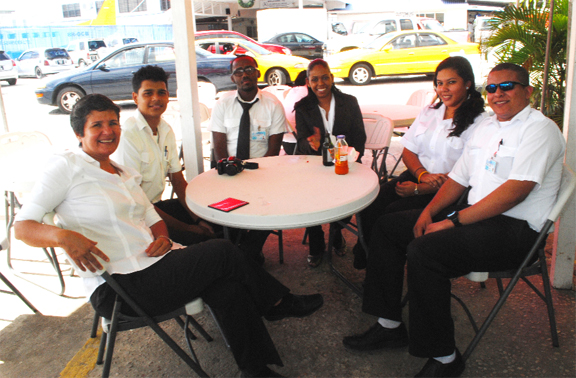As far as Annette Arjoon-Martins is concerned, Air Services Limited’s Flight Training School at Ogle is much more than a subsidiary of one of the most successful entities in the local aviation sector. It is, she believes, an important national institution. The woman whom, as the flight school’s Chief Executive Officer, has responsibility for ensuring the delivery of the syllabi that comprise four courses – Private Pilot’s Licence, Instrument Rating, Commercial Pilot Licence and Multi-Engine Rating – parades the school’s considerable achievements to make her point.
In April this year, the Guyana Civil Aviation Authority–approved Flight School celebrates its tenth anniversary and has trained pilots currently serving with all of the various service providers in the country’s aviation sector and a number of others in the Caribbean. One of the school’s graduates currently serves as Chief Pilot for the Guyana Defence Force. “These days you find pilots trained by ASL working for LIAT, Caribbean Airways and elsewhere. I believe that we have done a great job,” Arjoon-Martins says.

According to Arjoon-martins, ASL’s Flight School is the leading aviation training institution in both the Caribbean and South America. She says that one of the school’s current preoccupations is with increasing its market share in both the region and the hemisphere. What appears to be a delay in the approval of an application by the company for additional land space at a seemingly congested Ogle International Airport to create dormitories and other facilities necessary to both install additional infrastructure and accommodate overseas students places a temporary restraint on the school’s expansion plans. “Once we get the necessary approval of our application, I believe that we can be equipped to have foreign students train at the flight school within six months,” Arjoon-Martins says.
The advent of the flight school in 2003 was a response to a challenge which the parent company had set to increase the number of pilots available to fly its own aircraft in circumstances where both public and private sector demand for aviation services was increasing. More recently, the shift in investment attention to areas of the country not easily reached except by air, coupled with the need to provide enhanced levels of service to the Amerindian communities has imposed additional demands on the aviation. In response, ASL’s flight school has had to provide training beyond the confines of the company’s own operations. As a key member of the directorate of ASL, Annette Arjoon-Martins takes her leadership responsibility for the growth and development of the flight school seriously. More than that, she concedes that she has “an emotional attachment” to the school. She believes it is strategically positioned to hasten the growth of the domestic aviation sector and to serve as a launching pad for the strengthening links with the rest of South America by serving as a training institution for its pilots. Put differently, she believes the flight school can be the jewel in ASL’s crown and that it has the capacity to become a “stand-alone entity”.
Paradoxically, she also believes that the linkage that exists between the flight school and ASL provides the former with an important marketing advantage. Pilots who train with the flight school, she says, are provided with an opportunity to experience a more holistic aviation environment. “For example, the fact that ASL also provides a commercial aviation service affords students of the flight school the opportunity to become familiar with six different types of aircraft.”
Nor does she pass up such opportunities as may arise to attract pockets of local patronage to the school. During our interview she referred to the recent pronouncement by Home Affairs Minister Clement Rohee regarding plans to equip the police with aviation capacity. “We’d love to hear from the minister on the issue of training pilots,” she quipped. Beyond the domestic market, Arjoon-Martins believes the aviation sector offers as good an opportunity as exists for the strengthening of “south-south cooperation,” that is, co-operation between Guyana and the rest of South America in areas that may go beyond aviation. “We may well be the most accessible training institution that offers tuition in English available to the South American market. That being the case and if you bear in mind that pilots who serve the North American market need to be oriented in English, then our flight school becomes a valuable asset beyond Guyana and beyond the Caribbean,” she says.
The “standard qualification” for acceptance at the school is five CXC passes though Arjoon-Martins, herself a qualified pilot, says that learning to fly is “as much on attitude as on aptitude.” The Private Pilot’s Licence (PPL), or Visual Flight Rating (VFR) is a four-month course (it can go longer depending on the student’s availability to cover the minimum flight times) that allow for flight only when visibility is good. In order to successfully complete this course trainees must attend classes at ground school, complete 28 hours of dual flight and 12 hours of solo flight. Each student is also subjected to a “flight check” with the Guyana Civil Aviation Authority. The PPL allows the recipient “to fly for recreation and not for hire or reward.” This year, for the first time, the school will have its own Guyanese flight instructors. Arjoon-Martins says that whereas the school has traditionally had to depend on expatriate instructors, it has invested in the training of two Guyanese in the United States. Arjoon-Martins believes that the growth of ASL’s Flight Training School is coinciding with what she says is a period of “tremendous potential” aviation in Guyana. “We want the flight school to become the pillar of the company and my own assignment is to make that a reality,” she says.




